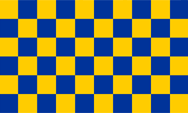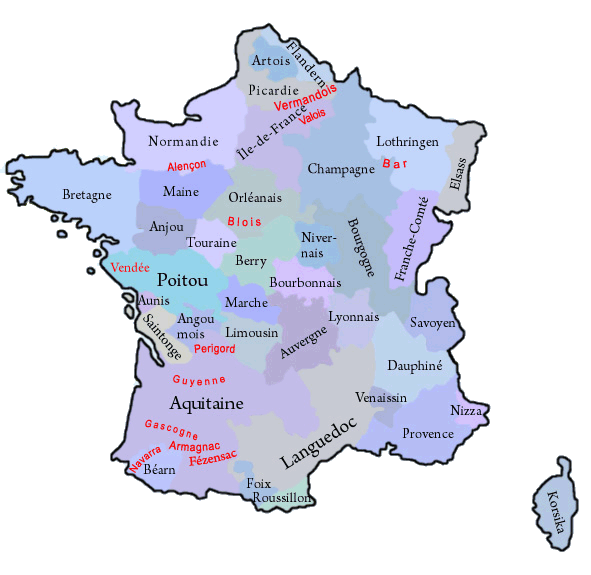mobile View, to the German Version tap the flag


- historical region in today's France
- former county
- part of the Picardy
• Flag
• Meaning/Origin of the Flag
• Coat of Arms
• Meaning/Origin of the Coat of Arms
• Map of the historical Regions in France
• Explanations about the Regions
• History
• Origin of the Country's Name

Flag of the County of Vermandois
– Drapeau de Comté de Vermandois,
Source, by: Wikipedia (FR)




The flag of Vermandois is a scutcheon flag, its design displays the image of the coat of arms of the Counts of Vermandois.
Source:
Volker Preuß


to 1077,
Coat of arms of the County of Vermandois
– Drapeau de Comté de Vermandois,
Source, by:
Wikipedia (FR)

The coat of arms of Vermandois is checkerboarded between gold and blue.
Source: Volker Preuß

The historical, French Regions:

in black: governorate and province in 1776,
in red: former county, province oder governorate
Map: Volker Preuß

The until the French Revolution existing provinces (or governorates) have been historically grown structures, which had their roots oftenly in former fiefdoms of the French crown, historic counties and duchies. They oftenly existed for hundreds of years and had preserved regionality (e.g. cultural particularities and regional languages). On the occasion of the French Revolution such phenomena were of course not desirable, and as part of their bloody and violent egalitarianism any regional references were eliminated. Shortly after the French Revolution the provinces were dissolved and France became divided into many départements, which should have approximately the same size and the same status. The départements were named after rivers or mountains, to use never and in no circumstances the name of an old province. However, there was no success in cutting the connections of the people of France to their respective regions, so that administrative regions were re-created in 1960, to have a better control in regional administrative processes. In this way became départements, which were placed in a historical province, administratively grouped to an oftenly historically named region. The resulted structures coincide only approximately with the boundaries of the old provinces. In the strictly centralist France any regionality is avoided, so that even the official flags of these regions mostly look like flags of companies, unloving, unhistorical, technocratic and modernistic, and these flags should not be a subject of any lexical considerations here. Only in a few of that regions, exist official flags which remember the historical models. But, even the existence of these today's regions is douptful, because in 2014 was passed a territorial reform valid from the year 2016, that reduces the number of the existing regions by merging to nearly the half. However, there exist unofficial flags in nearly all of these regions, which should remember the old provinces and the old heraldry.
Wikipedia Link to the regions of France:
click or tap here
FOTW Link to the regions of France:
click or tap here
Source: Flags of the World,
Wikipedia (D),
Volker Preuß

antiquity · settlement by the Celtic tribe of the Viromands
55 B.C. · Roman conquest
3rd century A.D. · settlement by Franks
481–843 · to the Frankish Empire
9th century · formation of the Viromandesian County (Latin: comitatus viromandensis), as fiefdom under the rule of the descendants of Count Bernhard of of the line of the Earlier Carolingians
880 · Treaty of Verdun and Ribbemont, at the division of the Frankish Empire the Viromandesian County comes to the West Frankish Kingdom (France)
902 · Count Heribert I. was murdered by order of the Count of Flanders
902–943 · reign of Heribert II., son of Heribert I., expansion and extension of the reign, imprisonment of the King of France (Charles the Simple)
946 · the Champagne, now consisting of the Counties of Troyes and Meaux, is given as a fief to the Counts of Vermandois (to 1019)
1076 · Heribert IV. receives by marriage with the heiress of Count Rudolf III. the County of Valois
ca 1077 · death of Heribert IV., the legacy comes through his daughter's (Adélaide) marriage to Hugo, the brother of the French King Philip I, out of the House of Capet
1102 · death of Hugo of Vermandois in Tarsus, the inheritance goes to the son Count Rudolf I. (Raoul), who married Alix of Guyenne, the sister of Eleanor of Aquitaine, rule until 1152 , he leaves three children: Raoul II. (Count from 1152 to 1167), Eleonore, and Mabile, who ruled over the counties of Vermandois, Valois and Amiens between 1167 and 1183 together with her husband Philip of Alsace
1183–1191 · reign of Count Philip of Alsace
1191 · death of Philip, the inheritance goes to Eleanor, the French King takes over Western Vermandois, Eleanor receives as Countess of Saint-Quentin the Eastern Vermandois
1214 · Eleonore waives in favor of the French King, the county falls entirely to the crown
1576 · Vermandois is conveyed to a duchy
1683 · death of Louis of Bourbon (son of Louis XIV.), the title of the Duke of Vermandois extincts, the fief goes to the family of Bourbon-Conde, the country is later connected to the royal province of Picardy
Source:
Wikipedia (D),
Brockhaus Konversationslexikon,
Meyers Konversationslexikon

The name "Vermandois" goes back to the Celtic tribe of the Viromands, who formerly lived here. In the 9th century was formed the Viromandesian County (Latin: comitatus viromandensis), the name was later shortened to "Vermandois".
Source:
Wikipedia (D)


![]()




